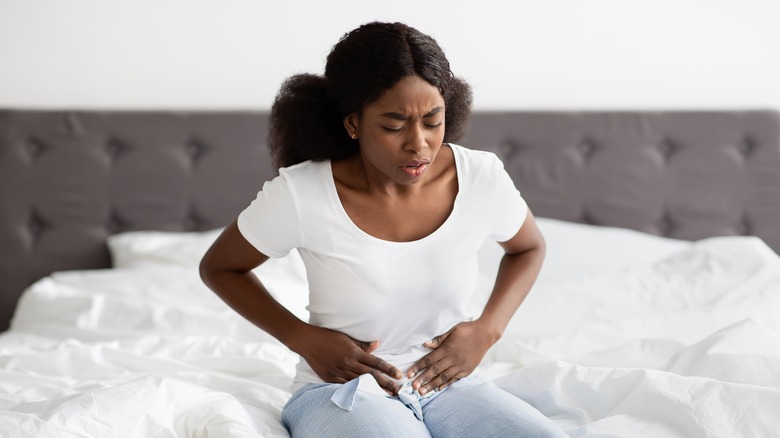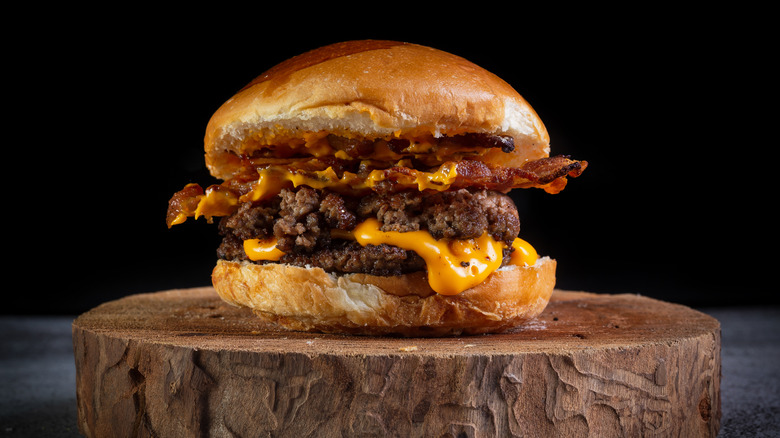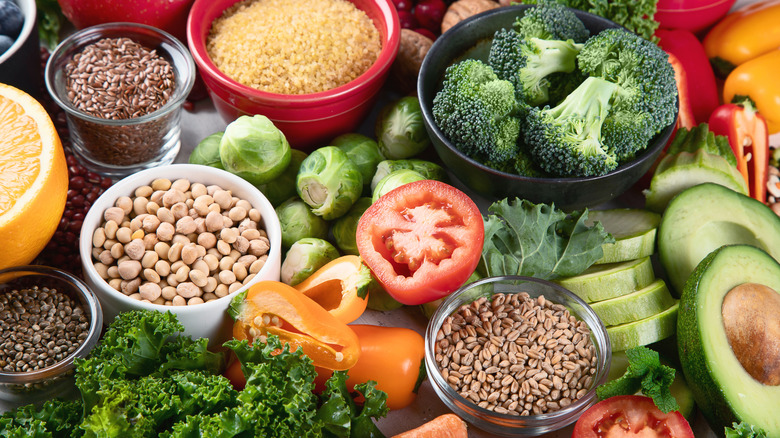Some Of Your Favorite Foods Might Make Your Menstrual Cramps More Severe
Period symptoms go far beyond cramping — in fact, you may be surprised to learn all that can happen to your body during your menstrual cycle. During the two to seven days that the average person bleeds (adding up to about seven years throughout the course of a lifetime) you may notice everything from mood swings to stubborn hormonal acne. As noted by Healthline, changes in estrogen and progesterone levels in the days leading up to your period can result in a desire for high-carb foods — these comfort meals also increase serotonin, aiding with the emotional symptoms associated with your menstrual cycle. So, next time you have an intense desire for your cinnamon roll, Aunt Flo might be on the horizon.
According to Unicef, approximately 26% of the population gets a period. Given those statistics, it's surprising how little we are taught about hormonal cycles and the ways to combat the sometimes-painful symptoms associated with menstruation — sure, an Advil can provide temporary cramp relief, but what about more long-term solutions? During our cycles, diet plays a surprising role in the intensity of period pain. Unfortunately, some of your go-to foods might be the very thing exacerbating cramps.
Cut back on red meat and sodium during your period
During our menstrual cycles, the uterus contracts to expel its lining. In the process, prostaglandins are released — these are the lipids that cause uterine cramping and ultimately result in back and muscle pain. Medical News Today reports on a recent North American Menopause Society (NAMS) study, noting that red meat, oil, sugars, and salt can lead to an increased production of prostaglandins, therefore making those annoying period cramps even worse.
Though red meats like beef are high in prostaglandins and can increase inflammation, white meats and fish are safe to consume, Healthline notes. Unfortunately, it's also best to cut back on morning coffee during that time of the month. Like sodium, caffeine increases water retention and, therefore, period bloating. However, cutting back on certain foods should by no means entail eating less. "Keeping your body nourished with nutrient-dense foods all month long is the way to go," explains registered dietician Valerie Agyeman to Cosmopolitan. As Agyeman goes on to advise, "Honor your cravings! Restriction and deprivation eventually may lead to overeating, which is followed by guilt and more restriction — it's a cycle."
For some, uterine cramps prove unmanageable. As reported by Medical News Today, a 2017 Nigerian Medical Journal study found that a staggering 13% of teenage girls have missed school due to cramps. However, just as some foods worsen period pain, other foods also have the ability to improve symptoms.
Leafy greens and beans can improve cramping
As advised by registered dietician Valerie Agyeman to Cosmopolitan, "Include whole grains, lean protein, fruits, vegetables, seeds, nuts and legumes into your eating routine" during that time of the month. Medical News Today also advises anti-inflammatory foods — try oily fish like salmon, anchovies, or sardines (don't worry, you don't have to put them on your pizza). Since red meat is typically a great source of protein, replace it with other protein-rich foods during the week of your period. Tofu, lentils, beans, and quinoa are all rich in the proper nutrients, according to Healthline. Leafy greens — really, anything a deer might like to snack on — will help maintain iron levels. Check out these veggie alternatives to red meat for some period-week recipe ideas — treat it as an opportunity for experimentation!
Certain herbal remedies, too, are said to improve cramping. Ginger, for instance, has anti-inflammatory properties (via Healthline). Next time you're struggling to get up from the couch during your period, heat up a mug of ginger tea to relax those aches and pains. Perhaps most importantly, make sure to drink lots and lots of water during your menstrual cycle. This will help with bloating and prevent possible dehydration.


